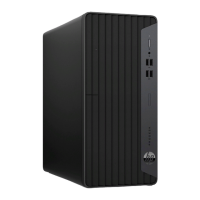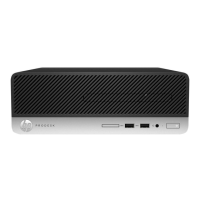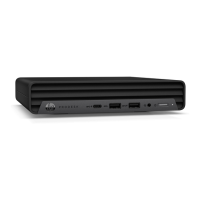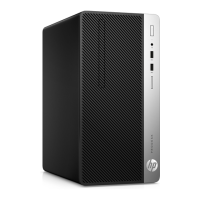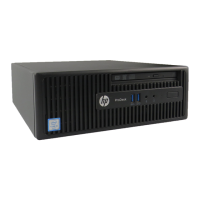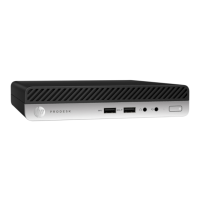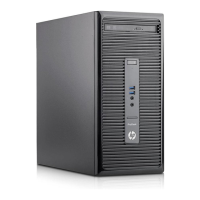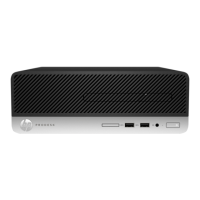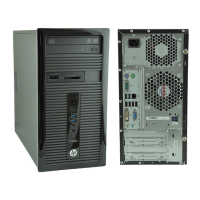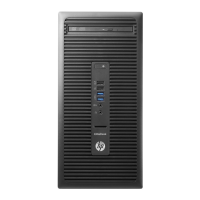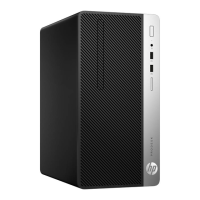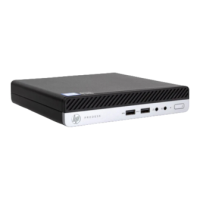Do you have a question about the HP ProDesk 400 G7 SFF and is the answer not in the manual?
Overview of typical computer configurations and features.
Identification and description of front panel connectors and controls.
Identification and description of rear panel connectors and controls.
Location of the computer's serial and product ID numbers.
Identification of main internal computer components with descriptions.
Identification of available hard drives, SSDs, and optical drives.
Identification of various computer cables and their descriptions.
Identification of other computer parts not categorized elsewhere.
Information on preventing damage to electronic components from static electricity.
Guidelines to prevent overheating and prolong computer life.
Safety measures to follow when cleaning computer components.
Procedures for cleaning the computer's exterior case.
Procedures for cleaning the computer keyboard.
Procedures for cleaning the computer monitor screen and body.
Procedures for cleaning the computer mouse.
Tools and software needed for servicing the computer.
Proper handling and precautions for hard drives.
Steps to prepare the computer for disassembly and reassembly.
Procedures for removing and installing the computer's access panel.
Procedures for removing and installing the optical drive.
Procedures for removing and installing the computer's front bezel.
Procedures for removing and installing the hood sensor module.
Procedures for removing and installing memory modules (DIMMs).
Procedures for removing and installing expansion cards.
Procedures for removing and installing the computer's drive cage.
Procedures for removing and installing computer hard drives.
Procedures for removing and installing the computer speaker.
Procedures for removing and installing the WLAN module.
Procedures for removing and installing solid-state drive modules.
Procedures for removing and installing the computer's fan shroud.
Procedures for removing and installing the computer's heat sink assembly.
Procedures for removing and installing the computer's processor.
Procedures for removing and installing the computer's power supply.
Procedures for removing and installing the computer's internal battery.
Procedures for removing and installing the computer's system board.
Steps to take before contacting technical support for computer issues.
Troubleshooting common computer issues like system freezes and response problems.
Identifying and resolving issues related to computer power supply and startup.
Troubleshooting common issues related to hard drive errors and performance.
Identifying and resolving issues related to computer memory installation and errors.
Troubleshooting common software errors and startup issues.
How to access and use the Computer Setup (F10) Utility for system configuration.
Configuring security settings like passwords and TPM within Computer Setup.
Advanced system configuration options including boot order and device settings.
Understanding numeric codes and text messages displayed during Power-On Self-Test (POST).
Diagnosing POST issues using front panel lights and audible beep codes.
Procedures for changing or setting system and power-on passwords.
Procedures for removing existing system and power-on passwords.
Using the Windows-based utility to diagnose hardware failures.
Running diagnostic tests outside the OS using the UEFI environment.
Customizing and using remote diagnostics features for select HP products.
Methods for backing up data and creating recovery media using Windows or HP tools.
Procedures for restoring the system to a previous state or factory settings.
Modifying the sequence of devices used for computer startup.
Restoring the HP OS image using the built-in Sure Recover feature.
Steps to restore nonvolatile memory to factory settings via BIOS.
Understanding nonvolatile memory types and their troubleshooting steps.
Common questions and answers regarding BIOS and nonvolatile memory.
Information on HP Sure Start technology for BIOS protection.
General requirements for power cord sets applicable to all countries.
Specific power cord requirements for use in Japan.
Additional power cord requirements specific to certain countries.
Physical dimensions of the computer system.
The approximate weight of the computer.
Operating and non-operating temperature ranges for the computer.
Maximum altitude at which the computer can operate.
Recommended relative humidity levels for computer operation.
Specifications related to the computer's power supply unit.
The standard efficiency rating of the power supply.
Overview of typical computer configurations and features.
Identification and description of front panel connectors and controls.
Identification and description of rear panel connectors and controls.
Location of the computer's serial and product ID numbers.
Identification of main internal computer components with descriptions.
Identification of available hard drives, SSDs, and optical drives.
Identification of various computer cables and their descriptions.
Identification of other computer parts not categorized elsewhere.
Information on preventing damage to electronic components from static electricity.
Guidelines to prevent overheating and prolong computer life.
Safety measures to follow when cleaning computer components.
Procedures for cleaning the computer's exterior case.
Procedures for cleaning the computer keyboard.
Procedures for cleaning the computer monitor screen and body.
Procedures for cleaning the computer mouse.
Tools and software needed for servicing the computer.
Proper handling and precautions for hard drives.
Steps to prepare the computer for disassembly and reassembly.
Procedures for removing and installing the computer's access panel.
Procedures for removing and installing the optical drive.
Procedures for removing and installing the computer's front bezel.
Procedures for removing and installing the hood sensor module.
Procedures for removing and installing memory modules (DIMMs).
Procedures for removing and installing expansion cards.
Procedures for removing and installing the computer's drive cage.
Procedures for removing and installing computer hard drives.
Procedures for removing and installing the computer speaker.
Procedures for removing and installing the WLAN module.
Procedures for removing and installing solid-state drive modules.
Procedures for removing and installing the computer's fan shroud.
Procedures for removing and installing the computer's heat sink assembly.
Procedures for removing and installing the computer's processor.
Procedures for removing and installing the computer's power supply.
Procedures for removing and installing the computer's internal battery.
Procedures for removing and installing the computer's system board.
Steps to take before contacting technical support for computer issues.
Troubleshooting common computer issues like system freezes and response problems.
Identifying and resolving issues related to computer power supply and startup.
Troubleshooting common issues related to hard drive errors and performance.
Identifying and resolving issues related to computer memory installation and errors.
Troubleshooting common software errors and startup issues.
How to access and use the Computer Setup (F10) Utility for system configuration.
Configuring security settings like passwords and TPM within Computer Setup.
Advanced system configuration options including boot order and device settings.
Understanding numeric codes and text messages displayed during Power-On Self-Test (POST).
Diagnosing POST issues using front panel lights and audible beep codes.
Procedures for changing or setting system and power-on passwords.
Procedures for removing existing system and power-on passwords.
Using the Windows-based utility to diagnose hardware failures.
Running diagnostic tests outside the OS using the UEFI environment.
Customizing and using remote diagnostics features for select HP products.
Methods for backing up data and creating recovery media using Windows or HP tools.
Procedures for restoring the system to a previous state or factory settings.
Modifying the sequence of devices used for computer startup.
Restoring the HP OS image using the built-in Sure Recover feature.
Steps to restore nonvolatile memory to factory settings via BIOS.
Understanding nonvolatile memory types and their troubleshooting steps.
Common questions and answers regarding BIOS and nonvolatile memory.
Information on HP Sure Start technology for BIOS protection.
General requirements for power cord sets applicable to all countries.
Specific power cord requirements for use in Japan.
Additional power cord requirements specific to certain countries.
Physical dimensions of the computer system.
The approximate weight of the computer.
Operating and non-operating temperature ranges for the computer.
Maximum altitude at which the computer can operate.
Recommended relative humidity levels for computer operation.
Specifications related to the computer's power supply unit.
The standard efficiency rating of the power supply.
| Chipset | Intel B460 |
|---|---|
| Form Factor | Small Form Factor |
| Processor | 10th Gen Intel Core i3/i5/i7 |
| Memory | Up to 64 GB DDR4-2933 SDRAM |
| Storage | Up to 2 TB HDD; Up to 1 TB SSD |
| Graphics | Intel UHD Graphics 630 |
| Operating System | Windows 10 Pro; Windows 10 Home; FreeDOS |
| Ports | RJ-45 |
| Expansion Slots | 1 PCIe x16, 1 PCIe x1 |
| Dimensions | 27 x 30.3 x 9.5 cm |
| Power Supply | 180 W internal power supply |
